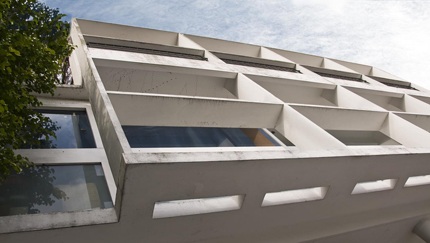
The Man Next Door
Directed by Mariano Cohn and Gastón Duprat
March 31
Museum of Modern Art
Roy and Niuta Titus Theater
1
11 West 53rd Street
New York, New York
April 1
Walter Reade Theater
165 West 65th Street
New York, New York
At the 2010 Sundance Film Festival in January, architecture was extolled, implicated, or otherwise showcased in several premieres. Last Address, a 9-minute elegy directed by Ira Sachs, depicts the facades of the final residences of New York City artists who died of AIDS. 12th & Delaware, by Rachel Grady and Heidi Ewing, profiles identical buildings at an intersection in Fort Pierce, Florida, one housing an abortion clinic, the other a pro-life headquarters, which are often mistaken for one other. I Am Love, by Luca Guadagnino and starring Tilda Swinton, takes place in the polished rooms of the Milanese villa of a wealthy industrial family, whose scion plans to meet Herzog & de Meuron.
But if a prize were given for best performance by a building, it would go to the Argentinian feature The Man Next Door, directed by Mariano Cohn and Gastón Duprat from a script by architect Andrés Duprat. That building would be the Curutchet House in La Plata, Argentina, Le Corbusier’s only residence in the Americas.
|
The house, shown in 2007, was originally built for a surgeon, Dr. Pedro Domingo Curutchet. J. Malik
the small courtyard separated the house from a ground-floor medical clinic.
Mario Chierico
|
The Man Next Door starts with a bang—literally. The opening features a split screen depicting a white stucco rectangle on the left and a field of black on the right. The relentless banging of a sledgehammer on the black side exposes a widening hole. Simultaneously, on the left side, the white stucco cracks. We’re on both sides of the wall at once.
The noise awakens Leonardo Kachanovsky, a 40-ish furniture designer, who sleepily shuffles across his Le Corbusier–designed residence to investigate. He passes a Corb chaise longue, Philippe Starck’s transparent Louis Ghost chairs, and a Cristián Mohaded Biblioteca Cons slanted bookcase, and makes his way down the house’s signature ramp to discover illegal construction work underway next door.
A new window is being pounded out of a solid exterior wall to “catch some rays” —in full view of Leonardo’s rear facade.
The interaction that ensues between Leonardo, the world-renowned industrial designer—his award-winning Konchanovsky Chair (actually, the Batti-designed Placentero Chair) was named “seat of the year” at the fictional Stockholm Biennale—and his charismatic bruiser of a neighbor, Victor, strangely both affable and threatening (and decidedly lower-class; Leonardo calls him a troglodyte) is at the heart of this comic but trenchant film.
Who hasn’t feared a nightmare scenario involving an aggressive next-door neighbor armed with a construction crew? Disruptions at all hours, invasions of privacy, aesthetic heresies? The Man Next Door stirs the pot further, adding conflicts of class and social status to those of substance and style.
Leonardo, the ostensibly self-satisfied Renaissance man, endures a litany of daily assaults. There’s his whiny bourgeois wife, Ana, who runs her yoga studio on the top floor, a circle of needy design students who bring models of Mies-derivative chaises for his evaluation, even a daily parade of architectural pilgrims who gather outside his landmark home. Then there’s his sullen teenage daughter, who is more charmed by the finger-puppet shows Victor stages in the makeshift proscenium of the questionable window aperture than the lame efforts of her priggish father.
We follow Leonardo as he shows off features of the Curutchet House to his students: the poplar tree in the courtyard around which the house is built, the brise soleil on the front facade, the modular system based on human scale. He takes us up and down the ramps, into the bedrooms, offices, kitchen, and terraces and through the double-height living space, the site of a wonderfully pretentious scene of listening to avant-garde music with an artsy friend, appreciating the “random thumping” in the music delivered by a “sub-woofer” when in fact it’s Victor’s industrious hammering.
Kidnapping is not unknown in Argentina and Leonardo hires a security expert. With a landmark house with no gate, easy street access, glass everywhere, cheek-by-jowl with adjoining houses on small lots, security is a tall order. And he refuses to install bars that would mar Le Corbusier’s design.
The Curutchet House, which starts off as emblematic of Leonardo’s perfectly constructed life—he even makes “designer chicken” for his guests—fractures in its meaning as The Man Next Door unfolds. It exposes his vulnerabilities and also his arrogance, selfishness, weak self-control, and ultimately, impotence. When the home is broken into by thieves, the separate actions of both Leonardo and Victor reveal the true nature of each man. Significantly, this takes place on Le Corbusier’s ramp.
The Man Next Door, which won a World Cinema Cinematography Award at Sundance, has its New York premiere at MoMA on March 31 as part of New Directors/New Films, co-sponsored by MoMA and the Film Society of Lincoln Center. It screens again at the Walter Reade Theater on April 1.
Read all of AN‘s Friday Reviews here.